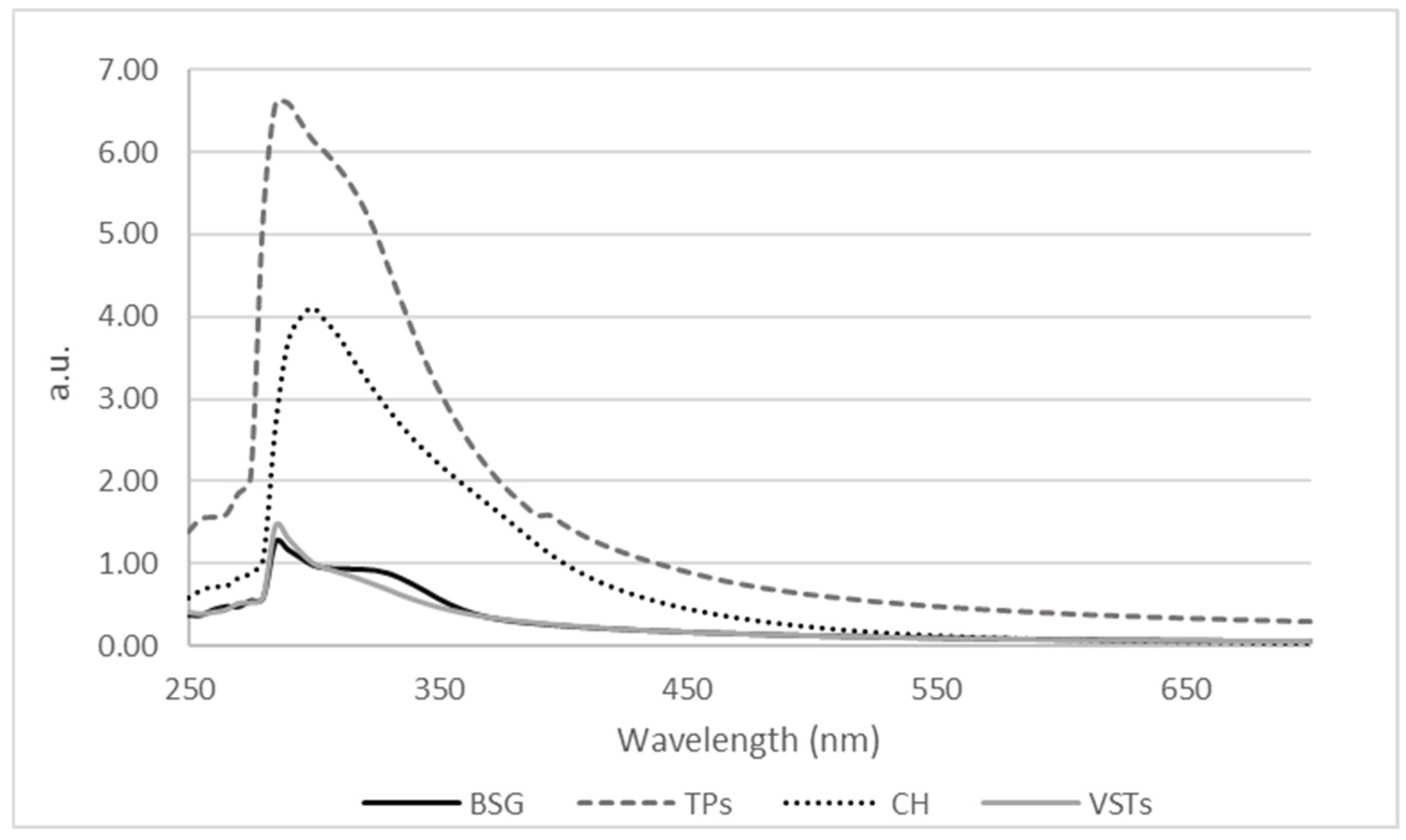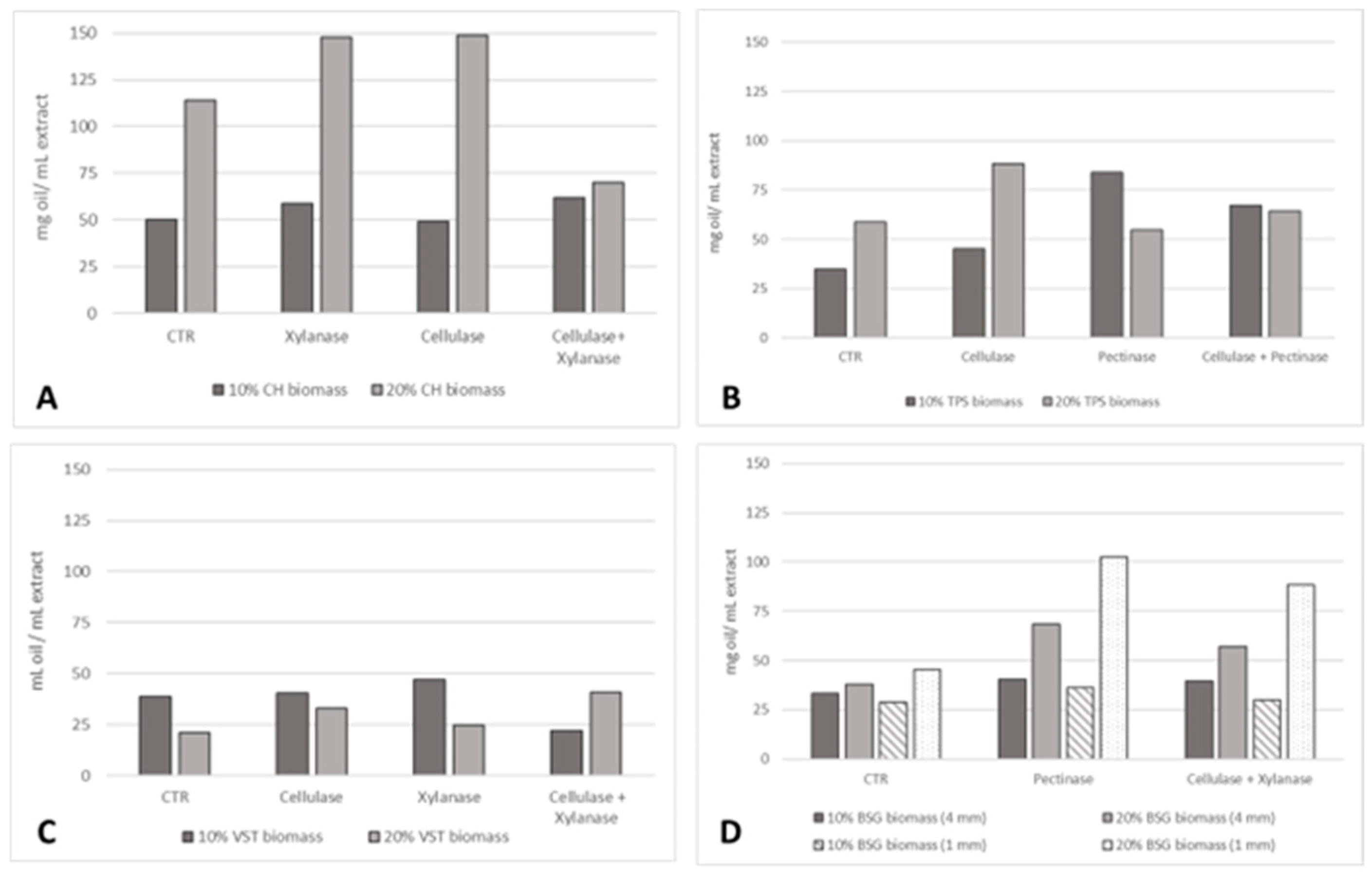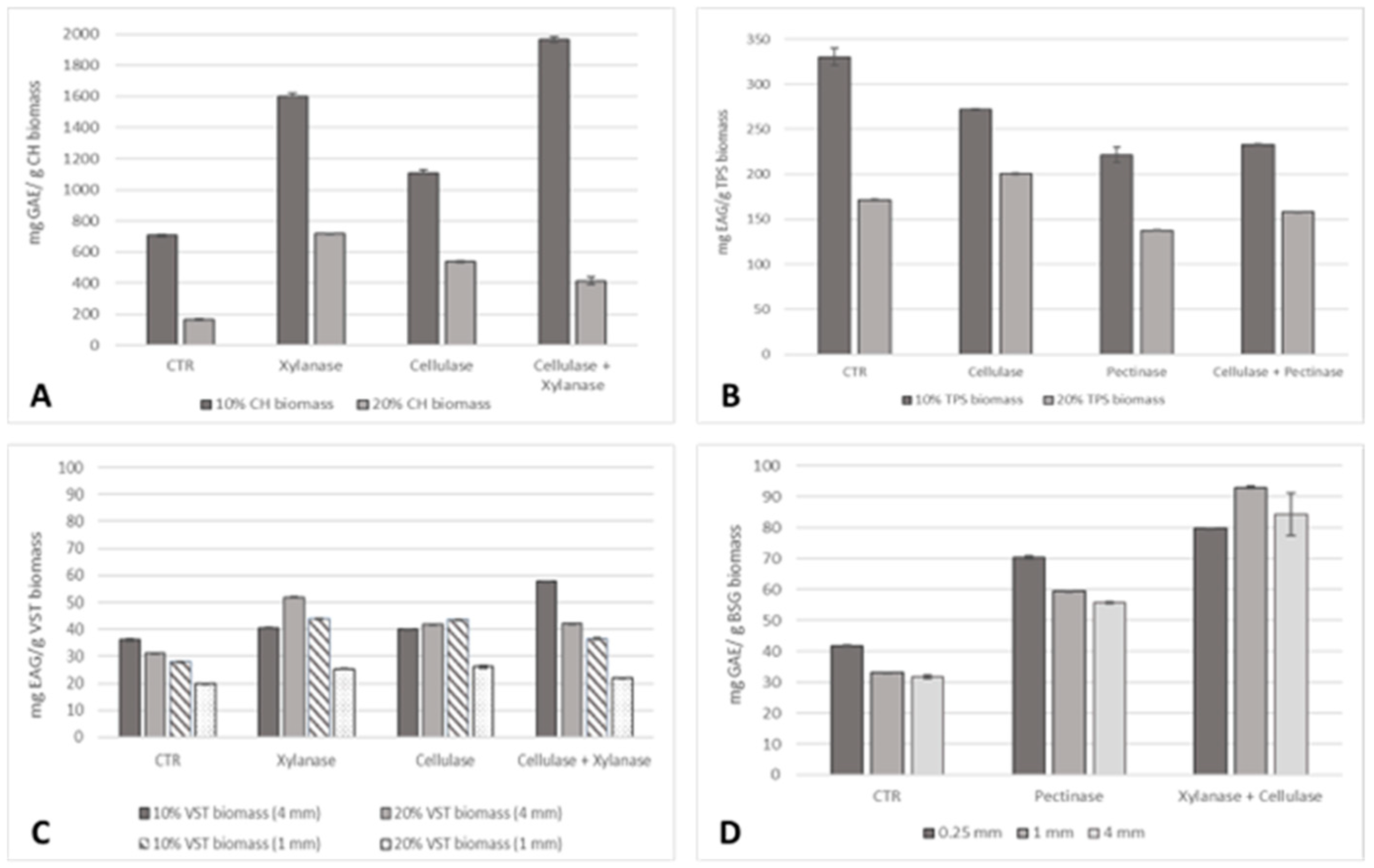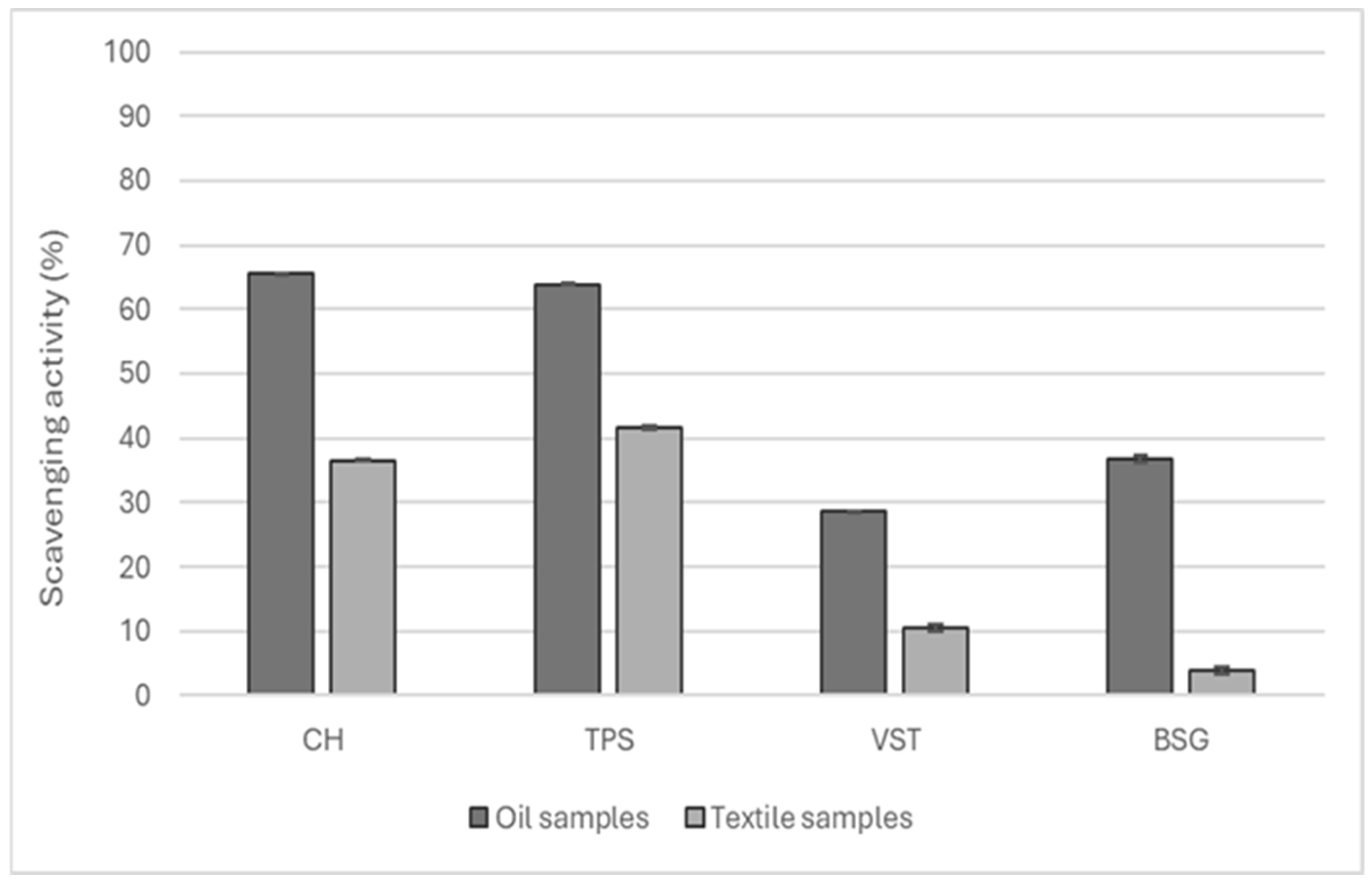Bioeconomy in Textile Industry: Industrial Residues Valorization Toward Textile Functionalization
Abstract
:1. Introduction
2. Results
2.1. Characterization of the Extracted Oils
2.2. Effect of Enzymatic Pre-Treatments on Oil Yield and Phenolic Compounds’ Extraction
2.3. Textile Functional Properties
3. Discussion
4. Materials and Methods
4.1. Raw Materials and Reagents
4.2. Physical Adequation of Residue Biomass
4.3. Oils’ Extraction and Recovery
4.4. Analytical Methods
4.5. Textiles Functionalization
4.6. Textile Functional Properties’ Evaluation
5. Conclusions
Author Contributions
Funding
Data Availability Statement
Acknowledgments
Conflicts of Interest
Abbreviations
| GHG | Greenhouse gas |
| EAMs | Enzyme-assisted aqueous methods |
| CH | Chestnut hedgehog |
| TPSs | Tobacco plant stems |
| BSG | Beer spent grain |
| VSTs | Vine shoot trimmings |
| UV | Ultraviolet |
| ATR-FTIR | Attenuated total reflectance–Fourier transform infrared spectroscopy |
| CIE | Commission Internationale de l’Éclairage |
| L* | Lightness |
| a* | Transition from green (−a*) to red (+a*) |
| b* | Transition from blue (−b*) to yellow (+b*) |
| K/S | Absorption coefficient—K—and scattering coefficient—S |
| TPC | Total phenolic content |
| EAG | Equivalent of gallic acid |
| DPPH | 2,2-diphenyl-1-picrylhydrazyl |
| UPF | Ultraviolet protection factor |
| WCA | Water contact angle |
| a.u. | absorbance units |
References
- European Parliament. The Impact of Textile Production and Waste on the Environment (Infographics). 2020. Available online: https://tinyurl.com/53jt6s6v (accessed on 1 April 2025).
- Arora, N.K.; Mishra, I. Responsible Consumption and Production: A Roadmap to Sustainable Development. Environ. Sustain. 2023, 6, 1–6. [Google Scholar] [CrossRef]
- Peng, X.; Jiang, Y.; Chen, Z.; Osman, A.I.; Farghali, M.; Rooney, D.W.; Yap, P.-S. Recycling Municipal, Agricultural and Industrial Waste into Energy, Fertilizers, Food and Construction Materials, and Economic Feasibility: A Review. Environ. Chem. Lett. 2023, 21, 765–801. [Google Scholar] [CrossRef]
- Eurostat. Waste Statistics. 2024. Available online: https://tinyurl.com/3y3w9pv6 (accessed on 1 April 2025).
- Pilafidis, S.; Diamantopoulou, P.; Gkatzionis, K.; Sarris, D. Valorization of Agro-Industrial Wastes and Residues through the Production of Bioactive Compounds by Macrofungi in Liquid State Cultures: Growing Circular Economy. Appl. Sci. 2022, 12, 11426. [Google Scholar] [CrossRef]
- Liu, X.; Li, S.; Chen, W.; Yuan, H.; Ma, Y.; Siddiqui, M.A.; Iqbal, A. Assessing Greenhouse Gas Emissions and Energy Efficiency of Four Treatment Methods for Sustainable Food Waste Management. Recycling 2023, 8, 66. [Google Scholar] [CrossRef]
- Gomes, J.M.; Mariz, J.; Rodrigues, C.; Alves, A.L.; Moreira, J.; Vieira, B.; Silva, R.M.; Zille, A.; Silva, C.J. Bioactive Compounds from Banana Leaf Extracts: Influence of Extraction Methodologies and Their Integration into Knitted Hemp Fabrics. Materials 2024, 17, 5884. [Google Scholar] [CrossRef]
- Afonso, T.B.; Bonifácio-Lopes, T.; Costa, E.M.; Pintado, M.E. Phenolic Compounds from By-Products for Functional Textiles. Materials 2023, 16, 7248. [Google Scholar] [CrossRef]
- Lemes, A.C.; Egea, M.B.; de Oliveira Filho, J.G.; Gautério, G.V.; Ribeiro, B.D.; Coelho, M.A.Z. Biological Approaches for Extraction of Bioactive Compounds From Agro-Industrial By-Products: A Review. Front. Bioeng. Biotechnol. 2022, 9, 802543. [Google Scholar] [CrossRef]
- Bolouri, P.; Salami, R.; Kouhi, S.; Kordi, M.; Asgari Lajayer, B.; Hadian, J.; Astatkie, T. Applications of Essential Oils and Plant Extracts in Different Industries. Molecules 2022, 27, 8999. [Google Scholar] [CrossRef]
- Tariq, H.; Rehman, A.; Raza, Z.A.; Kishwar, F.; Abid, S. Recent Progress in the Microencapsulation of Essential Oils for Sustainable Functional Textiles. Polym. Bull. 2024, 81, 7585–7629. [Google Scholar] [CrossRef]
- El-Molla, M.M.; El-Ghorab, A.H. Extraction of Eco-Friendly Essential Oils and Their Utilization in Finishing Polyester Fabrics for Fragrant and Medical Textiles. J. Eng. Fiber Fabr. 2022, 17. [Google Scholar] [CrossRef]
- Mehta, S.; MacGillivray, M. Aromatherapy in Textiles: A Systematic Review of Studies Examining Textiles as a Potential Carrier for the Therapeutic Effects of Essential Oils. Textiles 2022, 2, 29–49. [Google Scholar] [CrossRef]
- Zaharia, C.; Diaconu, M.; Muresan, E.I.; Danila, A.; Popescu, A.; Rosu, G. Bioactive Emulsions with Beneficial Antimicrobial Application in Textile Material Production. Cellulose 2020, 27, 9711–9723. [Google Scholar] [CrossRef]
- Stefanovic, B.; Kostic, M.; Bacher, M.; Rosenau, T.; Potthast, A. Vegetable Oils in Textile Finishing Applications: The Action Mode of Wrinkle-Reduction Sprays and Means for Analyzing Their Performance. Text. Res. J. 2014, 84, 449–460. [Google Scholar] [CrossRef]
- Tariq, Z.; Izhar, F.; Malik, M.H.; Oneeb, M.; Anwar, F.; Abbas, M.; Khan, A. Development of Functional Textile via Microencapsulation of Peppermint Oils: A Novel Approach in Textile Finishing. Res. J. Text. Appar. 2024, 28, 337–349. [Google Scholar] [CrossRef]
- Stan, M.S.; Chirila, L.; Popescu, A.; Radulescu, D.M.; Radulescu, D.E.; Dinischiotu, A. Essential Oil Microcapsules Immobilized on Textiles and Certain Induced Effects. Materials 2019, 12, 2029. [Google Scholar] [CrossRef]
- Nde, D.; Foncha, A. Optimization Methods for the Extraction of Vegetable Oils: A Review. Processes 2020, 8, 209. [Google Scholar] [CrossRef]
- Valladares-Diestra, K.; de Souza Vandenberghe, L.P.; Soccol, C.R. Oilseed Enzymatic Pretreatment for Efficient Oil Recovery in Biodiesel Production Industry: A Review. Bioenergy Res. 2020, 13, 1016–1030. [Google Scholar] [CrossRef]
- Dunford, N.T. Enzyme-Aided Oil and Oilseed Processing: Opportunities and Challenges. Curr. Opin. Food Sci. 2022, 48, 100943. [Google Scholar] [CrossRef]
- Fernandes, A.M.; Pinheiro, A.I.; Silva, C. Bioeconomy in Textile Industry: Industrial Wastes Valorisation Toward Textile Functionalization. 2024. In Proceedings of the 32nd European Biomass Conference and Exhibition, Marseille, France, 24–27 June 2024. [Google Scholar] [CrossRef]
- Sisa, M.; Bonnet, S.L.; Ferreira, D.; Van der Westhuizen, J.H. Photochemistry of Flavonoids. Molecules 2010, 15, 5196–5245. [Google Scholar] [CrossRef]
- Psomiadou, E.; Tsimidou, M. Stability of Virgin Olive Oil. 1. Autoxidation Studies. J. Agric. Food Chem. 2002, 50, 716–721. [Google Scholar] [CrossRef]
- Vázquez, G.; Fontenla, E.; Santos, J.; Freire, M.S.; González-Álvarez, J.; Antorrena, G. Antioxidant Activity and Phenolic Content of Chestnut (Castanea sativa) Shell and Eucalyptus (Eucalyptus globulus) Bark Extracts. Ind. Crops Prod. 2008, 28, 279–285. [Google Scholar] [CrossRef]
- Ogunkanmi, J.O.; Kulla, D.M.; Omisanya, N.O.; Sumaila, M.; Obada, D.O.; Dodoo-Arhin, D. Extraction of Bio-Oil during Pyrolysis of Locally Sourced Palm Kernel Shells: Effect of Process Parameters. Case Stud. Therm. Eng. 2018, 12, 711–716. [Google Scholar] [CrossRef]
- Yang, H.; Irudayaraj, J. Comparison of Near-infrared, Fourier Transform-infrared, and Fourier Transform-raman Methods for Determining Olive Pomace Oil Adulteration in Extra Virgin Olive Oil. J. Am. Oil Chem. Soc. 2001, 78, 889–895. [Google Scholar] [CrossRef]
- Wembabazi, E.; Mugisha, P.J.; Ratibu, A.; Wendiro, D.; Kyambadde, J.; Vuzi, P.C. Spectroscopic Analysis of Heterogeneous Biocatalysts for Biodiesel Production from Expired Sunflower Cooking Oil. J. Spectrosc. 2015, 2015, 8. [Google Scholar] [CrossRef]
- Agatonovic-Kustrin, S.; Ristivojevic, P.; Gegechkori, V.; Litvinova, T.M.; Morton, D.W. Essential Oil Quality and Purity Evaluation via FT-IR Spectroscopy and Pattern Recognition Techniques. Appl. Sci. 2020, 10, 7294. [Google Scholar] [CrossRef]
- Azadeh, E.; Chen, X.; Pizzi, A.; Gérardin, C.; Gérardin, P.; Essawy, H. Self-Blowing Non-Isocyanate Polyurethane Foams Based on Hydrolysable Tannins. J. Renew. Mater. 2022, 10, 3217–3227. [Google Scholar] [CrossRef]
- Krysa, M.; Szymańska-Chargot, M.; Zdunek, A. FT-IR and FT-Raman Fingerprints of Flavonoids—A Review. Food Chem. 2022, 393, 133430. [Google Scholar] [CrossRef]
- Rungruangkitkrai, N.; Phromphen, P.; Chartvivatpornchai, N.; Srisa, A.; Laorenza, Y.; Wongphan, P.; Harnkarnsujarit, N. Water Repellent Coating in Textile, Paper and Bioplastic Polymers: A Comprehensive Review. Polymers 2024, 16, 2790. [Google Scholar] [CrossRef]
- AS/NZ Standard 4399:2017; Sun Protective Clothing- Evaluation and Classification. Standards New Zealand: Welington, New Zealand, 2017.
- Lameirão, F.; Pinto, D.; Vieira, E.F.; Peixoto, A.F.; Freire, C.; Sut, S.; Dall’Acqua, S.; Costa, P.; Delerue-Matos, C.; Rodrigues, F. Green-Sustainable Recovery of Phenolic and Antioxidant Compounds from Industrial Chestnut Shells Using Ultrasound-Assisted Extraction: Optimization and Evaluation of Biological Activities In Vitro. Antioxidants 2020, 9, 267. [Google Scholar] [CrossRef]
- Hu, M.; Yang, X.; Chang, X. Bioactive Phenolic Components and Potential Health Effects of Chestnut Shell: A Review. J. Food Biochem. 2021, 45, e13696. [Google Scholar] [CrossRef]
- Kiralan, M.; Kiralan, S.S.; Özkan, G.; Karacabey, E. Chestnut (Castanea sativa) Oil. In Fruit Oils: Chemistry and Functionality; Ramadan, M., Ed.; Springer International Publishing: Cham, Switzerland, 2019; pp. 199–208. [Google Scholar]
- Ribeiro, J.E.; Rocha, J.; Queijo, L. The Influence of Manufacturing Factors in the Short-Fiber Non-Woven Chestnut Hedgehog Spine-Reinforced Polyester Composite Performance. J. Nat. Fibers 2021, 18, 1307–1319. [Google Scholar] [CrossRef]
- Rocha, J.Q.L. Production of Composite Thermosetting Resin Reinforced with Fibres from Autochthonous Plant, This Case Thorn from Hedgehog of Chestnut. In Proceedings of the In IDEMi 13, Porto, Portugal, 4 June 2013. [Google Scholar]
- Liu, Y.; Zhang, J.; Peng, F.; Niu, K.; Hou, W.; Du, B.; Yang, Y. Development of Chitosan-Based Films Incorporated with Chestnut Flower Essential Oil That Possess Good Anti-Ultraviolet Radiation and Antibacterial Effects for Banana Storage. Coatings 2024, 14, 548. [Google Scholar] [CrossRef]
- Miadonye, A.; Amadu, M.; O’Keefe, T.P. Spectroscopic Determination of the Synergistic Effect of Natural Antioxidants in Bio-Transformer Oils. Results Chem. 2023, 5, 100852. [Google Scholar] [CrossRef]
- Jović, O.; Habinovec, I.; Galić, N.; Andrašec, M. Maceration of Extra Virgin Olive Oil with Common Aromatic Plants Using Ultrasound-Assisted Extraction: An UV-Vis Spectroscopic Investigation. J. Spectrosc. 2018, 2018, 7510647. [Google Scholar] [CrossRef]
- Sadgrove, N.; Padilla-González, G.; Phumthum, M. Fundamental Chemistry of Essential Oils and Volatile Organic Compounds, Methods of Analysis and Authentication. Plants 2022, 11, 789. [Google Scholar] [CrossRef]
- Zou, X.; Bk, A.; Rauf, A.; Saeed, M.; Al-Awthan, Y.S.; Al-Duais, M.A.; Bahattab, O.; Hamayoon Khan, M.; Suleria, H.A.R. Screening of Polyphenols in Tobacco (Nicotiana tabacum) and Determination of Their Antioxidant Activity in Different Tobacco Varieties. ACS Omega 2021, 6, 25361–25371. [Google Scholar] [CrossRef]
- Zou, X.; BK, A.; Abu-Izneid, T.; Aziz, A.; Devnath, P.; Rauf, A.; Mitra, S.; Bin Emran, T.; Mujawah, A.A.H.; Lorenzo, J.M.; et al. Current Advances of Functional Phytochemicals in Nicotiana Plant and Related Potential Value of Tobacco Processing Waste: A Review. Biomed. Pharmacother. 2021, 143, 112191. [Google Scholar] [CrossRef]
- Sharma, Y.; Kaur, A.; Bhardwaj, R.; Srivastava, N.; Lal, M.; Madan, S.; Bala, K. Preclinical Assessment of Stem of Nicotiana Tabacum on Excision Wound Model. Bioorg. Chem. 2021, 109, 104731. [Google Scholar] [CrossRef]
- Prommaban, A.; Kheawfu, K.; Chittasupho, C.; Sirilun, S.; Hemsuwimon, K.; Chaiyana, W. Phytochemical, Antioxidant, Antihyaluronidase, Antityrosinase, and Antimicrobial Properties of Nicotiana tabacum L. Leaf Extracts. Evid. Based Complement. Altern. Med. 2022, 1, 5761764. [Google Scholar] [CrossRef]
- Zhao, J.; Ouyang, S.; Qi, H.; Ma, K.; Hu, X.; Wang, G.; Yang, X. Metabolomics and Transcriptomics Uncover the Pectin Hydrolysis during Tobacco Stem Fermentation by Aspergillus niger. J. Clean. Prod. 2024, 442, 141005. [Google Scholar] [CrossRef]
- Alara, O.R.; Abdurahman, N.H.; Ukaegbu, C.I. Extraction of Phenolic Compounds: A Review. Curr. Res. Food Sci. 2021, 4, 200–214. [Google Scholar] [CrossRef]
- Stanek-Wandzel, N.; Krzyszowska, A.; Zarębska, M.; Gębura, K.; Wasilewski, T.; Hordyjewicz-Baran, Z.; Tomaka, M. Evaluation of Cellulase, Pectinase, and Hemicellulase Effectiveness in Extraction of Phenolic Compounds from Grape Pomace. Int. J. Mol. Sci. 2024, 25, 13538. [Google Scholar] [CrossRef] [PubMed]
- Martillanes, S.; Ayuso-Yuste, M.C.; Bernalte, M.J.; Gil, M.V.; Delgado-Adámez, J. Cellulase-Assisted Extraction of Phenolic Compounds from Rice Bran (Oryza sativa L.): Process Optimization and Characterization. J. Food Meas. Charact. 2021, 15, 1719–1726. [Google Scholar] [CrossRef]
- Guimarães, A.; Mota, A.C.; Pereira, A.S.; Fernandes, A.M.; Lopes, M.; Belo, I. Rice Husk, Brewer’s Spent Grain, and Vine Shoot Trimmings as Raw Materials for Sustainable Enzyme Production. Materials 2024, 17, 935. [Google Scholar] [CrossRef] [PubMed]
- Putra, N.R.; Rizkiyah, D.N.; Aziz, A.H.A.; Mamat, H.; Jusoh, W.M.S.W.; Idham, Z.; Yunus, M.A.C.; Irianto, I. Influence of Particle Size in Supercritical Carbon Dioxide Extraction of Roselle (Hibiscus sabdariffa) on Bioactive Compound Recovery, Extraction Rate, Diffusivity, and Solubility. Sci. Rep. 2023, 13, 10871. [Google Scholar] [CrossRef]
- Ntalikwa, J.W. Solvent Extraction of Jatropha Oil for Biodiesel Production: Effects of Solvent-to-Solid Ratio, Particle Size, Type of Solvent, Extraction Time, and Temperature on Oil Yield. J. Renew. Energy 2021, 1, 1–8. [Google Scholar] [CrossRef]
- Gavahian, M.; Chu, Y.; Mousavi Khaneghah, A. Recent Advances in Orange Oil Extraction: An Opportunity for the Valorisation of Orange Peel Waste a Review. Int. J. Food Sci. Technol. 2019, 54, 925–932. [Google Scholar] [CrossRef]
- Vovk, H.; Karnpakdee, K.; Ludwig, R.; Nosenko, T. Enzymatic Pretreatment of Plant Cells for Oil Extraction. Food Technol. Biotechnol. 2023, 61, 160–178. [Google Scholar] [CrossRef]
- Waheed, A.; Akram, S.; Ashraf, R.; Mushtaq, M.; Adnan, A. Kinetic Model and Optimization for Enzyme-assisted Hydrodistillation of D-limonene-rich Essential Oil from Orange Peel. Flavour Fragr. J. 2020, 35, 561–569. [Google Scholar] [CrossRef]
- Wei, L.; Pu, D.; Mi, S.; Yang, H.; Wei, L.; Lu, Q.; Liu, M.; Zu, Y. Essential Oil Extraction and Evaluation from the Fresh Platycladus orientalis (L.) Franco Seed Peel Waste by an Environment-Friendly Method. Sustain. Chem. Pharm. 2022, 29, 100771. [Google Scholar] [CrossRef]
- Liu, Z.; Li, H.; Cui, G.; Wei, M.; Zou, Z.; Ni, H. Efficient Extraction of Essential Oil from Cinnamomum burmannii Leaves Using Enzymolysis Pretreatment and Followed by Microwave-Assisted Method. LWT 2021, 147, 111497. [Google Scholar] [CrossRef]
- Ferrentino, G.; Ndayishimiye, J.; Haman, N.; Scampicchio, M. Functional Activity of Oils from Brewer’s Spent Grain Extracted by Supercritical Carbon Dioxide. Food Bioprocess Technol. 2019, 12, 789–798. [Google Scholar] [CrossRef]
- Tagliaro, I.; Mariani, M.; Akbari, R.; Contardi, M.; Summa, M.; Saliu, F.; Nisticò, R.; Antonini, C. PFAS-Free Superhydrophobic Chitosan Coating for Fabrics. Carbohydr. Polym. 2024, 333, 121981. [Google Scholar] [CrossRef] [PubMed]
- Mohamed, A.L.; Sedik, A.; Mosaad, M.M.; Othman, H.A. Natural Oils\Silicon Based Materials for Imparting New Properties to Cellulose Based Fabrics. Results Chem. 2023, 5, 100812. [Google Scholar] [CrossRef]





| Residue | Color Coordinates from CIEL*a*b* Color Space | K/S | Color | ||
|---|---|---|---|---|---|
| L* | a* | b* | |||
| TPSs | 41.38 | 11.68 | 22.13 | 11.67 |  |
| BSG | 48.82 | 8.59 | 16.95 | 5.66 |  |
| CH | 43.29 | 9.62 | 21.00 | 11.87 |  |
| VSTs | 37.23 | 13.89 | 14.33 | 8.13 |  |
| Residue Biomass | Enzymatic Pre-Treatment | Contact Angle (°) | |
|---|---|---|---|
| Granulometry | Solids Loading (%) | ||
| 0.25 mm CH | 20% | Xylanase | 147.15 ± 12.30 |
| Xylanase + Cellulase | 160.45 ± 14.34 | ||
| 1.00 mm CH | 10% | Xylanase + Cellulase | 153.68 ± 5.97 |
| 20% | Xylanase + Cellulase | 127.52 ± 6.94 | |
| 0.25 mm VSTs | 10% | Xylanase + Cellulase | 149.87 ± 11.20 |
| 1.00 mm VSTs | 20% | Cellulase | 140.20 ± 16.06 |
| Xylanase | 149.72 ± 5.50 | ||
| Xylanase + Cellulase | 145.58 ± 9.52 | ||
| 4.00 mm VSTs | 10% | Xylanase + Cellulase | 156.36 ± 4.99 |
| 20% | CTR | 149.16 ± 8.56 | |
| 10 mm VSTs | 10% | CTR | 150.91 ± 8.01 |
| Xylanase + Cellulase | 149.37 ± 7.75 | ||
| 20% | CTR | 141.73 ± 4.26 | |
| Cellulase | 154.89 ± 11.81 | ||
| Xylanase + Cellulase | 156.26 ± 4.59 | ||
| 0.25 mm BSG | 10% | Pectinase | 144.02 ± 4.56 |
| Xylanase + Cellulase | 139.59 ± 5.64 | ||
| 20% | Pectinase | 156.18 ± 7.83 | |
| 30% | CTR | 150.84 ± 6.15 | |
| Pectinase | 151.71 ± 10.77 | ||
| 1.00 mm BSG | 10% | CTR | 156.50 ± 12.30 |
| Pectinase | 156.67 ± 2.85 | ||
| Xylanase + Cellulase | 149.61 ± 5.89 | ||
| 4.00 mm BSG | 10% | CTR | 147.05 ± 5.67 |
| Pectinase | 148.88 ± 15.58 | ||
| 20% | Xylanase + Cellulase | 142.45 ± 5.89 | |
| TPSs | 20% | Pectinase | 157.89 ± 4.14 |
| Cellulase | 147.05 ± 10.71 | ||
| Oils Used to Functionalize Textile Samples | UPF | L* | a* | b* | K/S | Color |
|---|---|---|---|---|---|---|
| CH 0.25 mm at 10% with Xylanase | 30 | 78.23 | 5.60 | 6.76 | 2.99 |  |
| CH 0.25 mm at 10% with Cellulase | 15 | 79.81 | 5.57 | 3.12 | 2.62 |  |
| CH 0.25 mm at 20% with Cellulase + Xylanase | 15 | 83.72 | 4.20 | 7.79 | 2.81 |  |
| CH: 0.25 mm at 20% with Cellulase | 15 | 85.11 | 3.64 | 7.63 | 2.71 |  |
| CH 1 mm at 10% with Cellulase | 15 | 79.95 | 4.37 | 11.92 | 3.35 |  |
| CH 1 mm at 20% with Xylanase | 15 | 81.00 | 4.32 | 10.51 | 2.96 |  |
| CH 1 mm at 20% (CTR) | 15 | 81.76 | 4.34 | 10.02 | 2.85 |  |
| CH1 mm at 10% with Xylanase | 15 | 75.80 | 5.53 | 13.86 | 3.43 |  |
| CH 1 mm at 20% with Cellulase | 15 | 79.21 | 4.66 | 11.44 | 3.19 |  |
| CH 1 mm at 10% (CTR) | 15 | 82.55 | 4.07 | 21.21 | 3.42 |  |
| CH 1 mm at 20% with Cellulase + Xylanase | 15 | 85.43 | 4.10 | 5.33 | 2.57 |  |
| CH: 1 mm at 10% with Cellulase + Xylanase | 15 | 86.38 | 3.80 | 4.54 | 2.53 |  |
| CH 4 mm at 20% with Cellulase + Xylanase | 15 | 81.28 | 5.17 | 6.74 | 2.62 |  |
| CH 4 mm at 10% (CTR) | 15 | 81.62 | 5.25 | 10.02 | 2.83 |  |
| CH 4 mm at 20% (CTR) | 15 | 86.38 | 3.46 | 7.38 | 2.59 |  |
| BSG 0.25 mm at 10% (CTR) | 15 | 83.39 | 5.02 | 4.27 | 2.29 |  |
| VSTs 1 mm at 10% with Xylanase | 15 | 81.27 | 5.23 | 5.65 | 2.30 |  |
| VSTs 1 mm at 10% with Cellulase + Xylanase | 15 | 85.37 | 5.01 | 1.86 | 2.19 |  |
| VSTs 4 mm at 10% with Xylanase | 15 | 79.24 | 5.20 | 6.96 | 2.61 |  |
| TS at 10% (CTR) | 30 | 77.75 | 5.29 | 12.58 | 2.92 |  |
| TS at 20% with Cellulase | 15 | 87.38 | 3.98 | 4.01 | 2.29 |  |
Disclaimer/Publisher’s Note: The statements, opinions and data contained in all publications are solely those of the individual author(s) and contributor(s) and not of MDPI and/or the editor(s). MDPI and/or the editor(s) disclaim responsibility for any injury to people or property resulting from any ideas, methods, instructions or products referred to in the content. |
© 2025 by the authors. Licensee MDPI, Basel, Switzerland. This article is an open access article distributed under the terms and conditions of the Creative Commons Attribution (CC BY) license (https://creativecommons.org/licenses/by/4.0/).
Share and Cite
Fernandes, A.M.; Pinheiro, A.I.; Rodrigues, C.; Silva, C.J. Bioeconomy in Textile Industry: Industrial Residues Valorization Toward Textile Functionalization. Recycling 2025, 10, 78. https://doi.org/10.3390/recycling10020078
Fernandes AM, Pinheiro AI, Rodrigues C, Silva CJ. Bioeconomy in Textile Industry: Industrial Residues Valorization Toward Textile Functionalization. Recycling. 2025; 10(2):78. https://doi.org/10.3390/recycling10020078
Chicago/Turabian StyleFernandes, Ana M., Ana Isabel Pinheiro, Catarina Rodrigues, and Carla J. Silva. 2025. "Bioeconomy in Textile Industry: Industrial Residues Valorization Toward Textile Functionalization" Recycling 10, no. 2: 78. https://doi.org/10.3390/recycling10020078
APA StyleFernandes, A. M., Pinheiro, A. I., Rodrigues, C., & Silva, C. J. (2025). Bioeconomy in Textile Industry: Industrial Residues Valorization Toward Textile Functionalization. Recycling, 10(2), 78. https://doi.org/10.3390/recycling10020078




